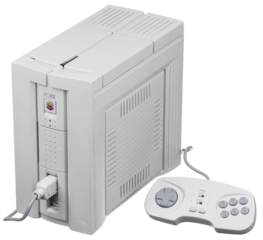PC-FX
From NEC Retro
Revision as of 06:49, 21 January 2017 by Black Squirrel (talk | contribs)

| ||||||||||
| PC-FX | ||||||||||
|---|---|---|---|---|---|---|---|---|---|---|
| Manufacturer: NEC | ||||||||||
|
This short article is in need of work. You can help NEC Retro by adding to it.
The PC-FX (ピーシー エフエックス) is a video game console created by NEC as a successor to the PC Engine and its many add-ons and derivatives. After a protracted development timeline, it was released in Japan in December 1994.
Contents
Hardware
The PC-FX stands as a curious mid-point between traditional early-90s video game consoles and desktop computers (of which NEC already had a healthy stake in with the PC-9800 series line). It resembles a typical upright (albeit smaller) mid-90s PC, however is designed to play video games shipped on CD-ROMs with a traditional, six-button controller - the FX-Pad.
The CD drive is located on the top of the unit (a design also witnessed in the PC-8801 MC), and the console is designed to be expandable. No keyboard was ever manufactured for the PC-FX, meaning it was never suited to traditional office software such as word processing, but a mouse was created in the form of the FX-MOU, primarily used for strategy games. The PC-FX can be linked up to a PC-9800 series to act as a CD-ROM drive, however.
Technical Specifications
History
Development
Developement on a 32-bit "Tetsujin" ("Iron Man") system began at NEC in around 1990[1], with the eventual aim of clawing back Japanese video game market share once held by the PC Engine prior to the release of the dominating Super NES.
Tetsujin was re-worked into the PC-FX during 199x, gaining a different CPU alongside other changes[1].
50-60 people worked on the FX project (both from a design and engineering point of view)[1]. Similarly to the PC Engine, Hudson Soft were also involved in the PC-FX's development, having a say in the manufacture of some components[1].
NEC had planned to sell 50,000 consoles in Japan per year[2].
Similar to the delays imposed on the Sega Saturn and PlayStation, NEC were cautious about releasing the system in North America due to fears the system would cost too much[1].
Release
Legacy
The PC-FX was considered by the Japanese public to be an expensive and underpowered system. Its lack of native 3D capabilities put it at a disadvantage against the Sega Saturn and Sony's PlayStation which had debuted in the same holiday season, and the console was largely shunned by third-party developers as a result. Only a hundred thousand units were produced as opposed to the millions of PC Engines, and the system did not leave Japan in any form, with even NEC citing price as a concern in Western markets.
Despite initial claims to the contrary, NEC imposed unusual directives on PC-FX developers, with software being skewed towards popular anime series with pre-rendered animated footage[3]. Throughout the system's life, virtually all software released for the machine capitalised on its ability to stream video (and load high quality stills) from CD. While polygonal 3D titles had been demonstrated alongside Tetsujin prototypes (most notably Super Star Soldier 3D), no 3D games were ever released on the PC-FX.
In early 1998 the console was discontinued, and NEC effectively left the home console business.
Magazine articles
- Main article: PC-FX/Magazine articles.